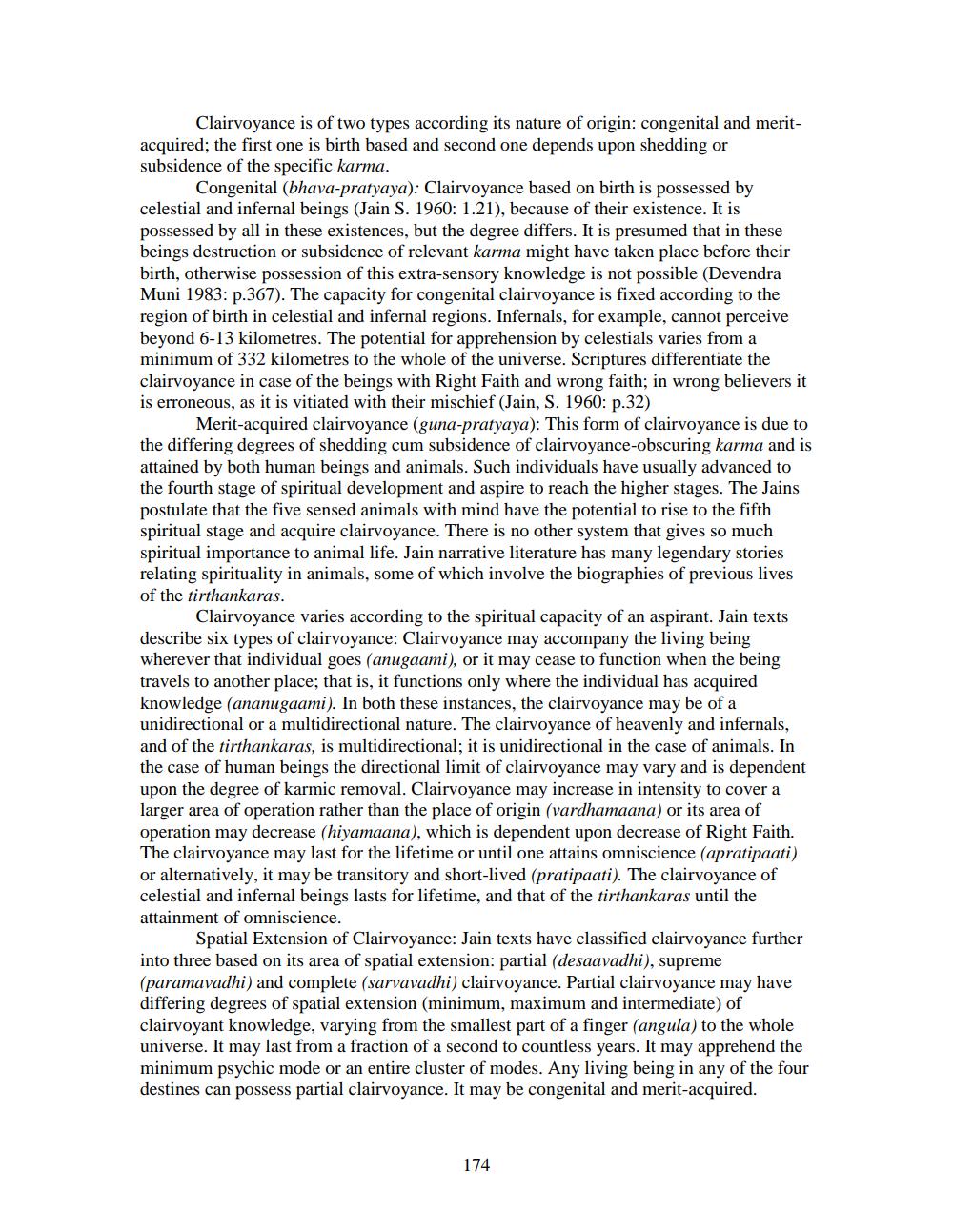________________
Clairvoyance is of two types according its nature of origin: congenital and meritacquired; the first one is birth based and second one depends upon shedding or subsidence of the specific karma.
Congenital (bhava-pratyaya): Clairvoyance based on birth is possessed by celestial and infernal beings (Jain S. 1960: 1.21), because of their existence. It is possessed by all in these existences, but the degree differs. It is presumed that in these beings destruction or subsidence of relevant karma might have taken place before their birth, otherwise possession of this extra-sensory knowledge is not possible (Devendra Muni 1983: p.367). The capacity for congenital clairvoyance is fixed according to the region of birth in celestial and infernal regions. Infernals, for example, cannot perceive beyond 6-13 kilometres. The potential for apprehension by celestials varies from a minimum of 332 kilometres to the whole of the universe. Scriptures differentiate the clairvoyance in case of the beings with Right Faith and wrong faith; in wrong believers it is erroneous, as it is vitiated with their mischief (Jain, S. 1960: p.32)
Merit-acquired clairvoyance (guna-pratyaya): This form of clairvoyance is due to the differing degrees of shedding cum subsidence of clairvoyance-obscuring karma and is attained by both human beings and animals. Such individuals have usually advanced to the fourth stage of spiritual development and aspire to reach the higher stages. The Jains postulate that the five sensed animals with mind have the potential to rise to the fifth spiritual stage and acquire clairvoyance. There is no other system that gives so much spiritual importance to animal life. Jain narrative literature has many legendary stories relating spirituality in animals, some of which involve the biographies of previous lives of the tirthankaras.
Clairvoyance varies according to the spiritual capacity of an aspirant. Jain texts describe six types of clairvoyance: Clairvoyance may accompany the living being wherever that individual goes (anugaami), or it may cease to function when the being travels to another place; that is, it functions only where the individual has acquired knowledge ananugaami). In both these instances, the clairvoyance may be of a unidirectional or a multidirectional nature. The clairvoyance of heavenly and infernals, and of the tirthankaras, is multidirectional; it is unidirectional in the case of animals. In the case of human beings the directional limit of clairvoyance may vary and is dependent upon the degree of karmic removal. Clairvoyance may increase in intensity to cover a larger area of operation rather than the place of origin (vardhamaana) or its area of operation may decrease (hiyamaana), which is dependent upon decrease of Right Faith. The clairvoyance may last for the lifetime or until one attains omniscience (apratipaati) or alternatively, it may be transitory and short-lived (pratipaati). The clairvoyance of celestial and infernal beings lasts for lifetime, and that of the tirthankaras until the attainment of omniscience.
Spatial Extension of Clairvoyance: Jain texts have classified clairvoyance further into three based on its area of spatial extension: partial (desaavadhi), supreme (paramavadhi) and complete (sarvavadhi) clairvoyance. Partial clairvoyance may have differing degrees of spatial extension (minimum, maximum and intermediate) of clairvoyant knowledge, varying from the smallest part of a finger (angula) to the whole universe. It may last from a fraction of a second to countless years. It may apprehend the minimum psychic mode or an entire cluster of modes. Any living being in any of the four destines can possess partial clairvoyance. It may be congenital and merit-acquired.
174




